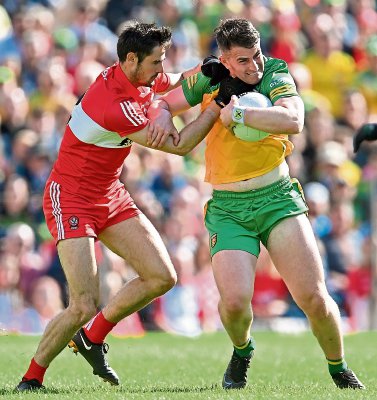THE year is 1993, and Derry are All-Ireland champions. At the victory banquet, there is a shot of Joe Brolly and Marty Morrissey, each smiling ear to ear. Like Down two years previously, the seismic proportions of victory are beyond the comprehension of delirious men, women, and children alike.
A cup of shimmering silver is decorated in the ribbon of the Oak Leaf men. They take more pride in their colours than most, and here in a hotel in the capital city lies a symbol of unification for communities torn apart by adversity. The red of a county, the red of Derry, filling the boots of an all too recognisable, damned crimson.
Dublin is no stranger to a north-south divide, a magnified version of an island where the word “identity” is forever followed by a question mark. Even in the most troubled times, Brolly and Morrissey could exchange a grin in the capital. The water that has accumulated under that bridge since would make the Liffey look as pure as the River Jordan.
One wonders what John Hume must have thought of it all when he lay on his death bed in August of 2020, leaving the promised land of peace on Earth for the promised land of eternity. So many deals reached, so many principles agreed.
Building bridges like some sort of metaphorical engineer, defying those intent on burning them. And yet in simpler times, we are as confused as ever.
Many on the northern side of the border have been casted aside as outsiders, cursed by ignorance rather than violence.
“We obviously feel it in the North. It’s a very real sense that exists, being looked down upon, being looked at differently, being spoken of differently. Whether it’s a conscious thing on behalf of people in the south, it’s hard to tell, but we feel it.”
The Irish News’ Cahair O’Kane was one of those lucky enough to witness Derry grasp the Anglo-Celt Cup for the first time in 24 years. A tense, tactical battle was to be expected, and so it ensued. A fine summer’s day in Clones combined with Ulster’s showpiece event to awaken the town from its 364-day hibernation.
St Tiernach’s Park absorbed the noise, the colour, and the 30,000-odd sets of intertwined fingers to forge an atmosphere of what O’Kane labels “pure claustrophobia”.
But it seemed as though the narrative had already been written. Brolly’s old friend Morrissey was particularly critical in his RTÉ commentary, and on Derry’s march to an All-Ireland semi-final, the talk was all about a style of play. The recognition of achievement was skirted over, no doubt adding fuel to the Rory Gallagher fire, and leaving Derry as the latest side to be embodied in the image of the “chippy” northerner.
“Derry were seen as a ‘horrible defensive’ team, and a ‘horrible’ team to watch’, but go back to the game between Galway and Mayo last year, and Galway caught Mayo out by playing a double sweeper that Mayo couldn’t play through. That same narrative didn’t exist around the Connacht Championship, or ‘typical Connacht’.
“Limerick then tried to batten down the hatches against Kerry in the Munster Final and just weren’t good enough. If you want to watch Kerry go out and kick 1-27 or whatever it was that’s grand, but I know which I would have.
“Would I have last year’s Ulster Final, or the Leinster or Munster finals? It’s a non contest”.
There is no doubt that the Ulster Championship has been by far and away the most entertaining and competitive provincial competition over the last decade or more. Where does this bias originate from? Is it dissipating over time, or is the harsh reality still rife as an All-Ireland organisation operates across two states?
“It (the sentiment towards Ulster) exists because the North exists, and it will exist until such a day where there is a solution to the border and the six counties being cut adrift.
Even if you had a United Ireland, I don’t think it would change the sentiment very quickly, but maybe the sense of abandonment that we have in the North would lessen over time.”
O’Kane acknowledges too the actions of unionist politicians. Their inclination to “conflate the GAA and the IRA and make them one” is a bone of contention, with the GAA continuing to expand guided by an ethos of inclusion, leading to the establishment of East Belfast GAA amongst others.
Whether activity in Stormont has a ripple effect further south or not is up for debate, but The Sunday Game certainly has more of an influence than even its viewers may realise. Even as a mellow Pat Spillane skips off into the world of retirement, his “puke football” comment from two decades ago lingers like the smell of vomit itself.
Kerry, and more recently Dublin, have this privilege of innocence in the media. Paudie Clifford’s speech for Fossa in the aftermath of the Junior Club Football Final was the prime example.
But even the purest of purists can only demand a certain level of respect. No ambush ever took place without a plan and a good dose of belief. More often than not it has been the Derrys, the Tyrones, the Armaghs, and the Donegals of this world who have ruffled the feathers of the untouchable.
And that would make you think that perhaps this bias is not such a bad thing after all. Forever and a day, this has been a place where you earn your stripes, on the field or off it. Nice guys win nothing, and that may well mean that the “chippy northerners” from “up there” will carry that chip on the shoulder like a badge of honour.
Often contempt is the greatest motivator of them all.
Receive quality journalism wherever you are, on any device. Keep up to date from the comfort of your own home with a digital subscription.
Any time | Any place | Anywhere












